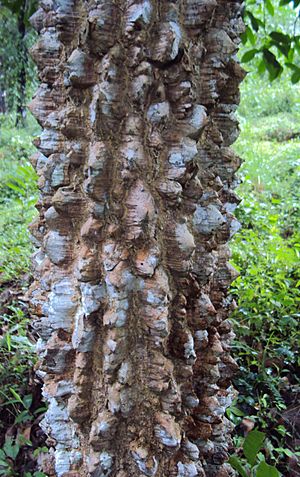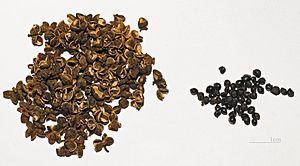Indian prickly ash facts for kids
Quick facts for kids Indian prickly ash |
|
|---|---|
 |
|
| Scientific classification | |
| Genus: |
Zanthoxylum
|
| Species: |
rhetsa
|
| Synonyms | |
|
|
The Indian prickly ash (scientific name: Zanthoxylum rhetsa) is a cool plant that grows as a shrub or a tree. It belongs to the Rutaceae family, which also includes citrus fruits like oranges! You can find this plant growing in many places, from India all the way to the Philippines and down to northern Australia.
This plant is special because it has cone-shaped spines on its older stems. Its leaves are "pinnate," which means they have many smaller leaflets arranged like a feather. The Indian prickly ash also produces clusters of white or yellowish flowers. After the flowers, it grows small, round fruits that can be red, brown, or black.
Contents
What Does It Look Like?
The Indian prickly ash can grow quite tall, sometimes reaching up to 26 meters (about 85 feet)! It's a deciduous plant, meaning it can shed its leaves, especially in drier seasons.
Stems and Leaves
Older stems of the plant have thick, cone-shaped spines. Imagine little pointy bumps sticking out! The leaves are pretty long, usually between 14 to 23 centimeters (about 5.5 to 9 inches). Each leaf has many smaller parts called leaflets, usually from nine to twenty-three of them. These leaflets are shaped like an egg or an oval.
Flowers and Fruits
The flowers of the Indian prickly ash grow in clusters called "panicles." These clusters can be up to 15 centimeters (about 6 inches) long. Each tiny flower has four small outer leaves called sepals and four white or yellowish-white petals.
The plant has both male and female flowers. Male flowers have parts that produce pollen, while female flowers have a part that develops into the fruit. This plant usually flowers in the summer. After flowering, it produces small, round fruits called "follicles." These fruits are about 6 to 7 millimeters wide and can be red, brown, or even black when ripe.
How It Got Its Name
The Indian prickly ash was first officially described in 1820 by a botanist named William Roxburgh. He first called it Fagara rhetsa. A few years later, in 1824, another botanist named de Candolle changed its name to Zanthoxylum rhetsa. This is the scientific name we use today!
Where It Grows
You can find the Indian prickly ash growing in places with lots of trees and plants, like rainforests and thick bushes near the coast. It grows from sea level up to about 200 meters (about 650 feet) high.
Its natural home stretches across a wide area. It's found in India, and then eastward through countries like the Philippines, and south into northern Australia. In Australia, it grows in specific areas like the northern Kimberley region in Western Australia, the northern coast of the Northern Territory, and the Cape York Peninsula in Queensland. It also grows on some islands in the Torres Strait, like Gabba and Moa Islands.
What Is It Used For?
The Indian prickly ash is quite useful! In some parts of India, especially in places like Goa, the Konkan and Kanara coasts, and Coorg, people use the outer part of its tiny fruits as a spice. It's especially popular in seafood dishes.
A Special Spice
This spice is known as "triphal" in Marathi and "teppal" in Konkani. Both names refer to the three parts of the fruit's outer shell. What's really interesting about this spice is that it contains a special chemical called sanshool. This chemical acts like a mild numbing agent and causes a cool, tingling sensation on your tongue when you taste it!
You might have heard of Sichuan pepper, which is famous for its numbing effect. That's because Sichuan pepper, which comes from a related plant called Zanthoxylum bungeanum, also contains sanshool. The Japanese and Korean pepper, Zanthoxylum piperitum, has it too!
Home for Butterflies
Besides being a spice, the Indian prickly ash is also important for many butterflies. They use it as a host plant. This means that butterflies lay their eggs on the plant, and when the caterpillars hatch, they eat its leaves to grow and develop. It's like a special nursery and food source for them!



